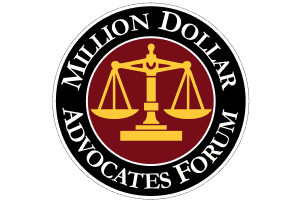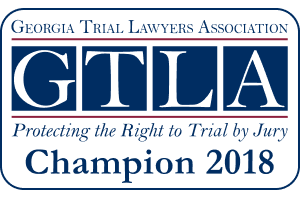Femur / thigh bone injuries

In decades as attorneys representing injured people in Georgia, we often have handled cases of broken femurs, also known as thigh bones.
In one such case arising from a truck crash, the jury in a conservative rural county in north Georgia surprised everyone with a verdict of $2,345,940.17. This jury verdict was about three times the highest previous verdict in the county’s history until then. It was nearly a million dollars more than the $1.3 million Johnson & Ward attorney Ken Shigley had requested in the closing argument. It was a scene reminiscent of the 1982 Paul Newman movie, “The Verdict.”
That required an injury lawyer to exercise meticulous attention to detail, creatively prepare for trial, and present of damages in an unexpected manner that gave jurors both motivation and a method to reach a more significant number on their own.
The femur is the longest and strongest bone in your body. Because it is so strong, it takes a great deal of force to break the shaft of the femur, at least in young people. That often happens in truck, car, and motorcycle crashes.
In older people with weaker bones, however, a simple fall may be enough to break the neck of the femur where it joins the pelvis.
There is a great variety of femur fractures, depending on the mechanism of injury, forces, and direction of impact. Bone fragments may be out of alignment (displaced fracture) or may line up well (stable fracture). Broken bone fragments may puncture the skin around the fracture (open fracture), or the skin may remain intact (closed fracture).
Femur shaft fractures are classified depending on:
- Pattern. The femoral shaft may break lengthwise, crosswise, or in the middle.
- Location. Location classifications divide the femur into thirds:
- Distal – lower third toward the knee
- Middle – obvious
- Proximal – upper third toward the hip
The most common types of femoral shaft fractures include:
- Transverse. Straight horizontal fracture line across the femoral shaft.
- Oblique. Angled fracture line across the shaft.
- Spiral – fracture encircles the shaft due to traumatic twisting forces in the thigh.
- Comminuted – thigh bone has broken into three or more pieces, with greater force usually producing a larger number of bone fragments.
- Open or compound – bone fragments protrude through the skin, or a wound penetrates to the broken bone. This type of fracture is called an open or compound fracture. These involve significantly more damage to the surrounding muscles, tendons, and ligaments and a high risk of infection and other complications that take a long time to heal.
Femur Fracture Diagnosis
Physical examination, with X-ray, CT, and MRI imaging, is used to determine the exact location and pattern of a femur fracture.
The patient should tell the doctor how the injury happened. That helps clarify the mechanism of injury. The physician will look for:
- Bones pushing on or through the skin
- Deformity of the thigh, such as a strange angle, shortening, or twisting of the leg.
- Breaks in the skin.
- Bruises.
After inspecting the leg, the doctor feels the leg, searching for abnormalities and tightness of the muscles and skin of the thigh, and checking pulses. If the patient is awake, the doctor tests for sensation and movement in the leg and foot.
Treatment for femur fracture may vary based on the type and location of the break and often includes:
- Setting the leg. A displaced fracture may require the broken bones to be realigned before splinting or casting the leg. Depending on the degree of displacement, surgical or nonsurgical methods may be used to manipulate the bones back into position. Severe or multiple fractures may require external fixation, which uses an outer metal rod and pins to hold the bone or bones in place until they heal.
- Open Reduction and Internal Fixation (“ORIF”) involves surgery and the use of an intramedullary rod or “nail” through the center of the bone, secured with various types of metal plates and screws. This hardware is usually left in the leg permanently though sometimes it may be removed or replaced. Advantages include a quicker return to weight-bearing, enhanced rehabilitation, and a higher bone union and fusion rate than external fixation. Potential disadvantages include increased risk of fat embolism, infection, blood loss, and a potential impediment to obtaining correct alignment.
We have handled severe femur fracture injury cases in which intramedullary fixation failed. In one case involving a femur shattered into several pieces, a small town hospital did not have the exact length of intramedullary rod immediately available. It was necessary to repeat the surgery a year later. The patient had a limp and a degree of permanent impairment, so he had to switch from construction to office work. - Immobilization through a splint or cast. Whether or not there is a surgical fixation of the fracture, femur fracture treatment usually involves splints or casts.
- Pain medication. Femur fractures are extremely painful. Physicians and patients must be aware of the delicate balance between pain control and the risk of narcotic dependency or addiction.
- Physical therapy. Most patients recovering from femur fractures require months of physical therapy (“PT”) to restore normal muscle strength, range of motion, and flexibility. The process can be very painful, but it helps recover function. Maximum improvement after a femur fracture can take anywhere from a few months to a few years. Some people have permanent impairments.
Permanent Impairments after Femur Fracture
In preparing for settlement or trial of femur injury cases, we typically obtain from the physician an impairment rating under the American Medical Association Guides to Evaluation of Permanent Impairment. In t femur injuries, determination of physical impairment involves complex tables and formulas that rate factors such as limb length discrepancy, muscle strength and atrophy, gait derangement, nerve injury, range of motion, complex regional pain syndrome, arthritis, and reduction of blood circulation. We also consider evaluation by a vocational rehabilitation expert to testify about real-world disability.
If you or a loved one has suffered a femur fracture in a truck, car, or motorcycle crash, call us at 404-253-7862.












